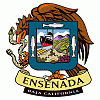Ensenada (Ensenada)
 |
Ensenada was founded in 1882, when the small community of Rancho Ensenada de Santos was made the regional capital for the northern partition of the Baja California Territory. The city grew significantly with the proliferation of mines in the surrounding mountains. While the Mexican Revolution curtailed much of Ensenada's expansion, the onset of Prohibition in the United States transformed the city into a popular tourist destination for Americans seeking entertainment and alcohol. Ensenada's reputation as a resort town was cemented by the 1950s and 1960s, which saw a construction boom and the city's rise in international prominence outside of North America.
Today, Ensenada is a major economic and cultural hub for Baja California. The city is home to numerous universities, like the Ensenada Institute of Technology and the Autonomous University of Baja California, Ensenada. Ensenada is an important biotechnology hub and is home to numerous research institutions, like the Ensenada Center for Scientific Research. The city is a member of the UNESCO Creative Cities Network.
At the time the first European explorers arrived in the region, the Yuman people inhabited the region. Yuman tribal groups such as the Kiliwa, Paipai and Kumeyaay still exist. These semi-nomadic indigenous people lived in the bay area and interior valleys of the Sierra de Juárez and San Pedro Mártir. The Kumeyaay had a village where the city is seated on, which was called Pa-tai.
Bahia Todos Santos, which Ensenada now borders, was first reached by sea by the Spanish explorer Juan Rodríguez Cabrillo on the vessels El Salvador and Victoria. The city was founded on September 17, 1542, under the name San Mateo. In 1602, while mapping the coast of the Californias in search of safe harbors for returning Spanish galleons from Manila to Acapulco, Sebastián Vizcaíno renamed the city to Ensenada de Todos Santos. Ensenada means "bay" or "cove".
The first permanent settlement was established by the Jesuits during the 17th or 18th century. After the expulsion of the Jesuits in 1768, the Dominicans took over the representation of Europe in what is now Ensenada. In 1805, José Manuel Ruiz Carillo obtained permission to establish himself in Ensenada, being appointed governor of Baja California and building in Ensenada a house that survived until the final part of that century, despite being briefly taken by William Walker, the self-declared "president" of the Republic of Lower California, in 1853–54. In 1882, Ensenada was designated the capital of Baja California, and attempts at developing the area were made by the English Mexican Land and Colonization Company. These were interrupted by the Mexican Revolution, which left the area devastated. In 1915, the capital was transferred to Mexicali, and in 1930, the population of Ensenada was only 5,000. During the early part of the twentieth century, the city's name was shortened from Ensenada de Todos Santos to Ensenada, a change made in order to avoid confusion with Todos Santos in Baja California Sur. The twentieth-century development of Ensenada was assisted by prohibition, which sent Americans and Canadians south of their border in search of entertainment and alcohol, developing first Tijuana, then Rosarito, and finally Ensenada as tourist destinations. The Hotel Riviera del Pacífico was opened in 1930, briefly placing Ensenada on the international glamor map and was visited several times by President Miguel Aleman, international artists and political personalities.
Ensenada truly began to flourish in the early 1950s, at which time the city's population had risen to 20,000. The hotel finally closed in 1964. It was later reopened as a cultural center and museum. By this time, other hotels had opened, and the population and economy of Ensenada had grown and diversified towards their present status.
On January 26, 2007, Pope Benedict XVI created the Roman Catholic Diocese of Ensenada with territory taken from the Archdiocese of Tijuana and Mexicali Diocese, making it a suffragan diocese of the Metropolitan Church of Tijuana.
Map - Ensenada (Ensenada)
Map
Country - Mexico
Currency / Language
| ISO | Currency | Symbol | Significant figures |
|---|---|---|---|
| MXV | Mexican Unidad de Inversion | 2 | |
| MXN | Mexican peso | $ | 2 |
| ISO | Language |
|---|---|
| ES | Spanish language |

















